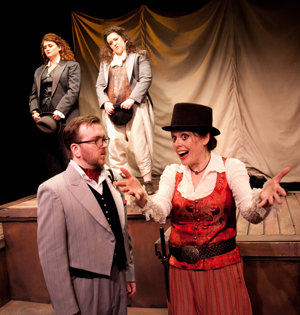
Nowadays we expect brain exercise from Tom Stoppard, but theatergoers in attendance at the 1967 premiere of Rosencrantz and Guildenstern Are Dead were unprepared for three acts of Hamlet's school chums parsing ontological philosophy, with occasional forays into existential pragmatism—all proposing (so the author claimed) to look at Shakespeare's tragedy, not from the perspective of its powerful monarchs, but the commoners caught up in covert intrigues beyond their comprehension.
Dramatic action operating on this many levels—did I mention the sly commentary on theatrical practices in vogue during the "swinging London" post-war years?—scarcely needs the addition of another one, but the Promethean Theatre Ensemble, perhaps fearing their audience succumbing to visual fatigue under Stoppard's onslaught of verbal dazzle, have staged their production to reflect the themes found in the 21st-century cult literary movement known as Steampunk.
For the uninitiated, "Steampunk" refers to a branch of science-fiction based in the conflicts between romanticism and industrialism prevalent in the Victorian age, when technology challenged the very foundations upon which western society had rested for centuries. Its graphic representation in pop culture is marked by fin-de-siecle fashions customized to include modern accouterments—a Boer war veteran with a welded-steel prosthetic arm, for example, or a tea-kettle cobbled together from clock parts or laboratory equipment.
Steampunk's followers affect a kind of dandified Gilded Age appearance—the leader of the traveling players wears a porkpie hat and motoring goggles, while Queen Gertrude sports a Princess Eugenie bonnet worn at a rakish angle—but the focus of their activities lie in tinkering and inventing, explains director Beth Wolf. This ars trouve aesthetic (what musician Tom Waits once dubbed "junkyard vaudeville") is evident in the street instruments of the itinerant orchestra—accordion, harmonica, spoons and bucket-drum—and the Cornell-box boutonnieres worn by our two bewildered heroes.
How does this connect with Stoppard's neo-absurdist universe? "Steampunk bridges worlds—historical Victorian sensibility with an imaginary future—in the same manner that Stoppard bridges the worlds of Shakespeare's Hamlet with the 'backstage' world created from the original play. This is what fueled our search for the best way to tell Stoppard's story. The design needs to be forceful enough to color the audience's experience, but not so strong that it overshadows the characters' journey. Steampunk evokes a sense of adventure, discovery—and whimsy, too—that we strive to capture in our production."
Do you anticipate audience members coming to the show dressed in Steampunk regalia? "Oh, we hope so! We are holding three post-show receptions in the Athenaeum's lounge—on May 2, 10 and 18—and encourage Chicago's Steampunk community to attend in costume."
Rosencrantz and Guildenstern Are Dead runs at the Athenaeum through May 24.
Mary Shen Barnidge
Contributing Writer

 Follow Us On Twitter
Follow Us On Twitter